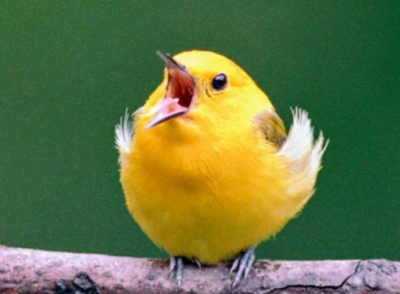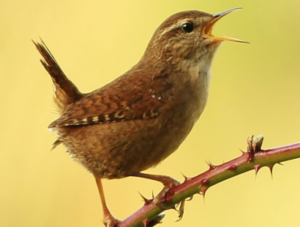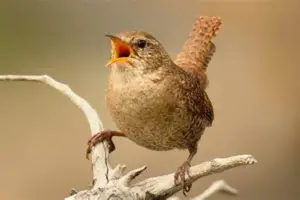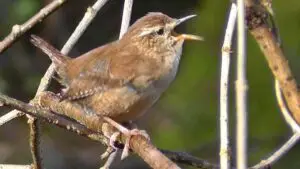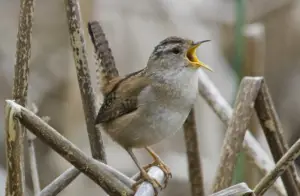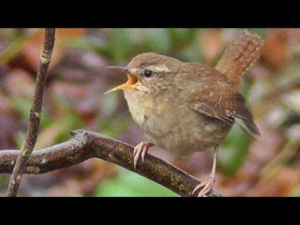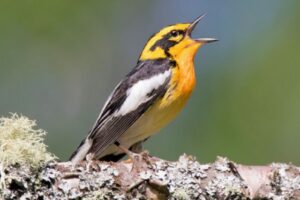Birdsong sounds, with their enchanting melodies and rhythmic choruses, have long fascinated and delighted both nature enthusiasts and casual observers. The rich tapestry of sounds produced by birds creates a symphony that fills the air with life.
Birdsong sounds play a crucial role in avian communication and behavior. They serve as a means of establishing and defending territories, attracting mates, and conveying social messages within a flock. Each species possesses its unique repertoire of vocalizations, ranging from complex and melodic songs to simple yet distinctive calls.
Birdsong sounds are not only a means of communication but also an expression of individuality, with each bird adding its unique voice to the symphony of the natural world.
The beauty and complexity of birdsong sounds have inspired poets, artists, and musicians throughout history. The captivating melodies and rhythmic patterns have been woven into human culture, with countless compositions, poems, and artistic representations drawing inspiration from the ethereal sounds of birds. Birdsong sounds awaken our senses, connecting us to the wonders of the natural world.
What are Birdsongs?
Birdsongs are the melodious and often complex vocalizations produced by birds. They encompass a wide range of sounds, including calls, songs, trills, chirps, warbles, and whistles. Birds use these sounds for various purposes, such as communication, courtship, territorial defense, and social interaction.
Birdsongs are highly diverse, with different species having distinct vocalizations that are unique to their kind. Each species has its repertoire of specific sounds and patterns, allowing birds to recognize and communicate with others of their kind. These vocalizations serve as a means of conveying information, establishing and defending territories, attracting mates, and maintaining social cohesion within flocks.
Birdsongs are often characterized by their complexity and musicality. Some birds produce intricate and elaborate songs with distinct phrases and notes, while others have simpler calls or repetitive patterns. The sounds can vary in pitch, rhythm, duration, and volume, creating a rich and diverse tapestry of avian vocalizations.
Birdsongs are not only functional but also serve aesthetic and cultural purposes. The beauty and intricacy of birdsongs have captivated humans for centuries, inspiring art, music, poetry, and scientific research. The melodic and enchanting qualities of birdsongs have the power to evoke emotions, connect us to nature, and provide a sense of wonder and appreciation for the avian world’s remarkable vocal abilities.
Importance and Significance of Birdsongs in Nature
Birdsongs play a vital role in the natural world, carrying immense importance and significance for both birds and their ecosystems. Here are some key reasons why birdsongs are essential:
- Communication: Birdsongs serve as a primary means of communication among birds. They convey crucial information about territory boundaries, mating availability, warnings of danger, and coordination within a flock. The complex and diverse vocalizations enable birds to effectively communicate with conspecifics and maintain social connections.
- Species Recognition: Birdsongs are unique to each species, acting as a vocal signature that helps birds identify and recognize members of their species. This is particularly crucial during breeding seasons when birds use songs to attract mates and establish breeding territories. Birdsongs ensure successful reproduction and the preservation of species diversity.
- Territory Defense: Birdsongs are essential for territorial defense. By singing, birds communicate their ownership of a specific area, deterring intruders and minimizing conflicts. The loud and distinct vocalizations help establish clear boundaries and prevent unnecessary physical confrontations between individuals.
- Ecosystem Balance: Birds play vital roles in ecosystems as pollinators, seed dispersers, and predators of insects and other small animals. Birdsongs contribute to ecosystem balance by attracting pollinators, dispersing seeds through their droppings, and alerting other species to the presence of predators or available food sources.
- Environmental Monitoring: Changes in birdsongs can indicate environmental changes and serve as an indicator of ecosystem health. Birdsong patterns can reflect variations in habitat quality, population size, and even climate conditions. Monitoring birdsongs can help scientists and conservationists track ecosystem dynamics and identify potential threats to avian populations.
- Aesthetic and Cultural Value: Birdsongs have captivated humans for centuries, evoking a sense of beauty, wonder, and connection to nature. They have inspired musicians, poets, and artists, becoming integral elements of cultural expressions worldwide. Birdsongs enrich our lives, bringing joy, tranquility, and a deeper appreciation for the natural world.
Overall, birdsongs are not merely melodious sounds; they are a crucial aspect of avian biology, behavior, and ecological interactions. Their significance lies in their role as communication tools, species identifiers, territory markers, and indicators of ecosystem health, while also providing cultural and aesthetic value to human societies.
Characteristics of Birdsongs (e.g., melody, rhythm, pitch)
Birdsongs encompass a variety of characteristics that contribute to their unique and captivating nature. Here are some key characteristics of birdsongs:
- Melody: Birdsongs often exhibit a melodic quality, featuring a series of musical notes and phrases. The arrangement of these notes creates distinct melodies that can be pleasing to the human ear. Some birds, such as thrushes and nightingales, are known for their elaborate and melodious songs with intricate sequences of notes.
- Rhythm: Birdsongs have rhythmic patterns, with regularity in the timing and spacing of notes. The rhythm can vary among different species and individuals, ranging from fast and continuous trills to slower and more deliberate sequences. The rhythmic nature of birdsongs adds structure and consistency to their vocalizations.
- Pitch: Birds produce sounds across a range of pitches, from low to high frequencies. The pitch of birdsongs is determined by the size and structure of the bird’s vocal apparatus, as well as its unique vocal capabilities. Some species, like the robin, have songs with lower pitches, while others, like canaries, produce songs with higher pitches.
- Phrases and Repetition: Birdsongs often consist of distinct phrases or motifs that are repeated in a sequence. These phrases can be short or long, consisting of a few notes or more complex arrangements. Birds may repeat certain phrases within their song, creating a recognizable pattern that helps identify their species and individual identity.
- Variability: Birdsongs can exhibit considerable variability within and between individuals. This variation can occur in terms of pitch, rhythm, melody, and even the addition of improvisations or unique flourishes. Some birds, like mockingbirds, are particularly renowned for their ability to mimic other bird species and incorporate a wide range of sounds into their songs.
- Learning and Cultural Transmission: Birdsongs are not solely instinctual but often learned and culturally transmitted. Young birds learn their species-specific songs by listening to and imitating adult birds. This learning process allows for the development of regional dialects and individual variations within a species, contributing to the diversity and richness of birdsongs.
The combination of melody, rhythm, pitch, phrases, and variability in birdsongs creates a fascinating auditory landscape in the natural world. Each species has its unique vocal repertoire, contributing to the intricate tapestry of sounds heard in diverse ecosystems worldwide.
Different Types of Birdsongs (e.g., calls, songs, territorial displays)
Birds produce a variety of vocalizations, each serving a different purpose. Here are some common types of birdsongs:
- Calls: Calls are short, simple vocalizations used for basic communication. They can convey various messages, including alarm calls to alert others of potential threats, contact calls to maintain group cohesion, or begging calls by young birds to solicit food from their parents. Calls are often distinct and can vary in pitch, rhythm, and intensity.
- Songs: Songs are more elaborate and melodious vocalizations primarily associated with courtship and territorial displays. Male birds, in particular, use songs to attract mates and establish their presence within a territory. Songs often consist of a series of repeated phrases, showcasing the bird’s vocal prowess and individuality. Each bird species has its unique song repertoire.
- Territorial Displays: Some birds use specialized vocalizations as part of their territorial displays. These vocalizations may include aggressive or territorial calls aimed at warning intruders to stay away from their defined territory. These displays serve to defend resources, establish breeding rights, and prevent conflicts between individuals of the same species.
- Mating Calls: Mating calls are specific vocalizations produced by birds during the breeding season to attract mates. These calls are often highly distinctive and can vary greatly between species. Males may use elaborate songs or distinctive calls to advertise their fitness and attract the attention of potential mates.
- Duetting: Duetting is a form of coordinated vocalization between male and female birds, usually pairs or mates. They engage in synchronized singing, alternating or overlapping their vocalizations to strengthen their bond, defend their territory, or reinforce pair bonding during breeding.
- Mimicry: Some bird species, such as mockingbirds and lyrebirds, are known for their exceptional ability to mimic the sounds of other birds and even environmental sounds. Their songs may incorporate imitations of other bird species, alarm calls, or human-made sounds. Mimicry adds complexity and versatility to their vocalizations.
- Lekking Displays: In certain species, males gather in specific areas called leks to engage in competitive displays to attract females. These displays often involve elaborate vocalizations, along with visual displays and posturing. The vocalizations used during lekking displays are typically loud, distinctive, and aimed at impressing females.
These are just a few examples of the various types of birdsongs. Each species has its unique repertoire of vocalizations, tailored to their specific needs and behaviors. The diversity of birdsongs adds richness and complexity to the acoustic environment, creating a fascinating symphony of sounds in the avian world.
How Birds Produce Sounds: Vocalization Mechanism
Birds produce sounds through a specialized vocalization mechanism located in their respiratory and vocal tract. Here’s an overview of how birds produce sounds:
1. Syrinx: The syrinx is the vocal organ of birds, located at the base of the trachea where it branches into the bronchi. It is unique to birds and is responsible for their diverse vocal abilities. The syrinx consists of muscles, membranes, and cartilage structures that can be controlled to produce a wide range of sounds.
2. Airflow: Birds produce sound by manipulating the airflow passing through the syrinx. The airflow originates from the lungs and travels up the trachea. Muscular control over the syrinx allows birds to modulate the airflow and create different sound patterns and frequencies.
3. Vibrating Membranes: Within the syrinx, there are specialized membranes called labia that vibrate to generate sound. The labia are controlled by muscles, and when air passes through them, they vibrate, producing sound waves.
4. Sound Modification: To further modify the sound, birds can manipulate the shape and tension of the vocal tract, which includes the beak, throat, and mouth. By adjusting the shape of these structures, birds can alter the resonance and quality of the sound produced, resulting in different vocalizations.
5. Vocal Learning: Some bird species can learn and imitate sounds from their surroundings, including other birdsongs, human-made sounds, or environmental noises. This vocal learning is facilitated by specialized brain circuits that enable birds to mimic and incorporate new sounds into their repertoire.
6. Species-Specific Vocalizations: Each bird species has its characteristic vocalizations shaped by genetic factors and cultural transmission. Young birds learn species-specific vocalizations from adult birds through a process called vocal learning. This learning ensures that individuals develop the appropriate vocalizations for their species.
The vocalization mechanism in birds is incredibly diverse, allowing for a wide array of sounds, from simple calls to complex songs. The specialized structure of the syrinx and the ability to modify the airflow and shape of the vocal tract contribute to the remarkable vocal abilities exhibited by different bird species. Birdsongs are an integral part of avian communication and behavior, enabling birds to convey information, establish territories, attract mates, and participate in complex social interactions.
Functions of Birdsongs (e.g., communication, mating, territorial defense)
Birdsongs serve a variety of important functions for birds, encompassing communication, mating, and territorial defense. Here are some key functions of birdsongs:
- Communication: Birdsongs are a primary means of communication among birds. They convey a wide range of information to other individuals of the same species, including territory boundaries, availability of mates, location of food sources, and warnings of potential threats. Birdsongs allow birds to maintain social connections, coordinate group activities, and establish individual identities within their species.
- Mating and Courtship: Birdsongs play a crucial role in attracting mates and facilitating courtship. Male birds often sing elaborate songs to demonstrate their fitness, advertise their presence, and attract females. These songs can serve as signals of genetic quality, health, and readiness for breeding. Females may also vocalize to indicate their receptiveness to mating, engage in duets with males, or respond to specific vocalizations.
- Territorial Defense: Birdsongs are used for territorial defense, marking and defending a specific area against intruders of the same species. Male birds may sing to establish their ownership of a territory, deter rival males, and warn intruders to stay away. These vocal displays help minimize physical confrontations and prevent unnecessary energy expenditure in conflicts.
- Individual Recognition: Birdsong’s aid in individual recognition among conspecifics. Each bird has its unique vocal signature, allowing individuals to identify and recognize each other. This recognition is crucial for maintaining social bonds, pair bonding, and parental care. Birdsongs enable individuals to distinguish between familiar and unfamiliar individuals within their social group.
- Species Identification: Birdsongs provide a means for species identification. Each bird species has its distinct vocal repertoire, consisting of specific patterns, melodies, and phrases. By listening to and recognizing the songs of other species, birds can identify potential competitors, predators, or suitable mates. Species-specific vocalizations contribute to the overall biodiversity and ecological balance in avian communities.
- Environmental Signaling: Birdsongs can also serve as environmental signals. Some bird species modify their vocalizations in response to changes in the environment, such as weather conditions or the presence of predators. These variations in vocalizations can convey information about habitat quality, resource availability, or potential dangers to other birds in the area.
The functions of birdsongs are multifaceted and essential for the survival and reproductive success of birds. Through their vocalizations, birds establish social connections, attract mates, defend territories, and navigate their environment. The intricate and diverse nature of birdsongs reflects the remarkable adaptability and complexity of avian communication.
Common Bird Species Known for Their Distinctive Songs
There are numerous bird species known for their distinctive and memorable songs. Here are a few examples:
- American Robin (Turdus migratorius): The melodious and flute-like song of the American Robin is one of the most recognizable sounds of spring. It consists of a series of clear whistled notes, often described as a cheerily, cheer-up, cheerio.
- Northern Mockingbird (Mimus polyglottos): The Northern Mockingbird is renowned for its exceptional ability to mimic the songs of other birds and incorporate a wide range of sounds into its repertoire. Its song consists of a medley of imitations, musical phrases, and repeated patterns.
- Blackbird (Turdus merula): The Blackbird, especially the male, is known for its rich and melodious song. It features a combination of fluting and whistling notes, often delivered from a prominent perch.
- Song Thrush (Turdus philomelos): The Song Thrush produces a distinctive and repetitive song. It typically includes a variety of rich, flute-like phrases repeated two or more times in a row.
- Nightingale (Luscinia megarhynchos): The Nightingale is famous for its beautiful and complex song, often heard during the breeding season. Its melodic song comprises a mixture of whistles, trills, and gurgles, delivered with incredible clarity and volume.
- Canary (Serinus canaria): Canaries are popular for their melodious and warbling song. Male canaries are particularly known for their impressive vocal abilities, producing a sequence of high-pitched notes and trills.
- Wood Thrush (Hylocichla mustelina): The Wood Thrush is known for its flute-like song, often described as ethereal and haunting. Its song features a series of clear, flute-like notes with rich harmonies.
- European Skylark (Alauda arvensis): The European Skylark is famous for its soaring and complex song. Male skylarks perform elaborate, continuous songs while in flight, combining melodious trills, warbles, and whistles.
- White-throated Sparrow (Zonotrichia albicollis): The White-throated Sparrow has a distinct song characterized by a series of clear, whistled notes. Its song often includes the phrase “Oh sweet Canada, Canada, Canada.”
- Red-winged Blackbird (Agelaius phoeniceus): The male Red-winged Blackbird produces a distinctive song composed of a variety of rich, flute-like notes and harsh, throaty calls. The song is often associated with wetland habitats.
These are just a few examples of bird species renowned for their unique and recognizable songs. Each species has its distinct vocal repertoire, contributing to the captivating and diverse world of birdsongs.
Birdsong Patterns and Seasonal Variations
Birdsongs exhibit various patterns and undergo seasonal variations, influenced by factors such as breeding behavior, territoriality, and environmental conditions. Here are some common patterns and seasonal variations in birdsongs:
- Breeding Season Songs: Many bird species intensify their singing during the breeding season. Males, in particular, use songs to establish territories and attract mates. Their songs become more frequent, complex, and conspicuous, serving as a vocal advertisement of their fitness and suitability as a mate.
- Dawn Chorus: One prominent pattern in birdsongs is the “dawn chorus.” During the early morning hours, especially around sunrise, numerous bird species engage in an intense period of singing. This behavior is believed to be related to the establishment of territories, defending resources, and attracting mates.
- Repertoire Development: Young birds often go through a learning phase where they acquire and refine their vocalizations. They start with simple, imitative sounds and gradually develop a more elaborate repertoire by imitating adult birds. This learning process can occur during the breeding season or outside of it, depending on the species.
- Seasonal Variations: Some bird species exhibit seasonal variations in their songs. For example, certain migratory birds may sing different songs during their breeding season in their breeding grounds compared to their non-breeding season in their wintering grounds. These variations can be influenced by the availability of suitable habitats, resources, and social interactions.
- Territory Defense: Birds use songs to defend their territories and communicate with neighboring individuals. This behavior is particularly pronounced during the breeding season when birds establish and maintain exclusive breeding territories. Songs are employed as vocal signals to deter intruders and communicate territorial boundaries.
- Vocal Overlaps: In areas with high bird species diversity, vocal overlaps can occur, where multiple species sing simultaneously. Birds have developed distinct frequency ranges, rhythms, and melodies to minimize acoustic interference and maintain their identities within a vocalizing community.
- Environmental Influences: Environmental factors such as temperature, weather conditions, and time of day can also affect birdsongs. Some bird species may adjust the timing, duration, or intensity of their singing in response to temperature fluctuations, atmospheric pressure, or light levels.
- Reproductive Suppression: In certain bird species, such as cooperative breeders or social species, some individuals may suppress their singing to prioritize assisting in rearing offspring or supporting the dominant breeding pair.
Birdsongs are dynamic and adaptive, shaped by both internal and external factors. They play a crucial role in bird communication, breeding behavior, and social interactions.
Cultural and Symbolic Meanings Associated with Birdsongs
Birdsongs have held cultural and symbolic significance in various human societies throughout history. Here are some examples of the cultural and symbolic meanings associated with birdsongs:
- Aesthetic Appreciation: Birdsongs have long been admired for their beauty and melodious qualities. The intricate melodies, varied pitches, and rhythmic patterns of birdsongs have inspired human musicians, composers, and poets. They are often celebrated as expressions of natural beauty and are incorporated into artistic works, including music, literature, and visual art.
- Cultural Symbolism: Birdsongs have held symbolic meanings in different cultures. In some indigenous traditions, specific bird songs are believed to carry messages from the spirit world or serve as omens and signs. Birdsongs may be associated with specific emotions, seasons, or events and may be interpreted as messages of joy, sorrow, or imminent changes.
- Spiritual and Religious Significance: Birdsongs have been associated with spirituality and religious beliefs in many cultures. They are often considered divine or transcendent sounds, representing the presence of higher powers or spiritual realms. Birdsongs are sometimes used in meditation practices to induce a state of calmness, connection with nature, or spiritual awakening.
- Folklore and Mythology: Birds and their songs feature prominently in folklore and mythology worldwide. Birdsongs are believed to have enchanted qualities, capable of bringing good fortune, warding off evil spirits, or signaling important events. In some mythological tales, birdsongs are associated with transformation, communication with supernatural beings, or guiding lost souls.
- Cultural Identity: Birdsongs can hold cultural significance and serve as symbols of regional or national identity. Some bird species are deeply connected to specific geographic areas or ecosystems, and their songs become emblematic of those places. They may be celebrated as iconic sounds that evoke a sense of place and belonging.
- Communication with Nature: Birdsongs have been celebrated as a means of connecting with the natural world. The ability to listen to and interpret birdsongs is seen as a way of understanding and appreciating the environment. Birdsongs can evoke a sense of harmony, vitality, and interconnectedness with the natural world.
- Therapeutic and Relaxation Purposes: The soothing effect of birdsongs has led to their use in therapeutic settings, such as sound therapy, relaxation techniques, and nature-based healing practices. Listening to birdsongs is believed to reduce stress, promote relaxation, and enhance overall well-being.
Birdsongs have resonated with humans on cultural, symbolic, and emotional levels for centuries.
Birdsongs in Soundscapes and Environmental Conservation
Birdsongs play a vital role in shaping the acoustic landscapes of natural environments. They contribute to the overall soundscape and ecosystem functioning. Here are some ways in which birdsongs are significant in soundscapes and environmental conservation:
- Biodiversity Assessment:
Birdsongs serve as acoustic indicators of biodiversity. By listening to and analyzing the variety of bird species and their vocalizations in an area, scientists and conservationists can assess the health and diversity of ecosystems. Changes in birdsong patterns and compositions can indicate shifts in habitat quality, population dynamics, and ecological disturbances.
- Habitat Monitoring:
Birdsongs provide valuable information for monitoring and managing habitats. By recognizing specific bird vocalizations, researchers can identify and track the presence and abundance of certain bird species. This data helps in assessing the success of conservation efforts, detecting changes in habitat conditions, and implementing targeted conservation strategies.
- Ecological Interactions:
Birdsongs reflect the interactions between bird species and their environment. For example, birdsongs are used in territorial defense, courtship displays, and mate selection. Studying these vocal interactions provides insights into the social dynamics, breeding behavior, and reproductive success of bird populations. Such knowledge is crucial for conservation planning and maintaining healthy ecosystems.
- Sound Pollution and Anthropogenic Disturbances:
Birdsongs can be affected by anthropogenic activities and noise pollution. Urbanization, industrialization, and increased human activity can lead to habitat degradation and noise disturbances that impact bird communication and breeding behavior. Monitoring changes in birdsong patterns can help assess the impact of human activities on bird populations and guide efforts to mitigate such disturbances.
- Public Awareness and Engagement:
Birdsongs have a unique ability to capture public attention and foster a connection with nature. Incorporating birdsongs in environmental education programs, nature reserves, and eco-tourism initiatives can raise awareness about the importance of preserving habitats and conserving biodiversity. Birdsongs serve as a powerful tool for engaging people in environmental conservation and promoting a sense of stewardship.
Soundscape Preservation:
Conserving birdsongs is part of the broader effort to preserve natural soundscapes. As human activities increasingly encroach upon natural habitats, maintaining undisturbed acoustic environments becomes crucial. Protecting the sounds of birdsongs contributes to the preservation of intact ecosystems, enhances the overall biodiversity, and supports the well-being of both wildlife and humans.
Understanding the role of birdsongs in soundscapes and environmental conservation allows us to appreciate the intricate connections between sound, biodiversity, and ecosystem health.
The Role of Birdsongs in Birdwatching and Identification
Birdsongs play a crucial role in birdwatching and bird identification, enhancing the overall experience and helping enthusiasts identify different bird species. Here are some ways in which birdsongs contribute to birdwatching and identification:
1. Species Recognition:
Birdsongs provide an auditory clue to the presence of specific bird species. Each bird species has a unique vocalization pattern, allowing experienced birdwatchers to identify them based on their songs or calls. By familiarizing themselves with the distinctive songs of various bird species, birdwatchers can locate and identify birds even when they are hidden from view.
2. Location and Presence:
Birdsongs help birdwatchers pinpoint the location of birds in their surroundings. The ability to recognize and interpret birdsongs allows birdwatchers to locate birds in dense vegetation, thick forests, or other challenging habitats where visual identification may be difficult. By following the direction and intensity of songs, birdwatchers can locate hidden or elusive species.
3. Breeding Behavior and Territoriality:
Birdsongs provide insight into the breeding behavior and territoriality of bird species. During the breeding season, male birds sing to attract mates and establish territories. By listening to their songs, birdwatchers can observe courtship displays, territorial interactions, and breeding activities. Birdsongs can reveal important behavioral information about the birds’ breeding status and their interactions with other individuals.
4. Species Diversity and Rarity:
The variety of birdsongs in an area can indicate the diversity and richness of bird species present. In areas with high species diversity, a chorus of different songs can indicate a rich avian community. Unusual or rare birdsongs can alert birdwatchers to the presence of less common or migrant species, adding excitement and value to birdwatching experiences.
5. Birding by Ear:
Birdsongs enable birdwatchers to engage in “birding by ear,” which is the practice of identifying birds primarily based on their vocalizations. This skill becomes particularly useful when visibility is limited, or when birdwatchers encounter species with cryptic plumage or similar visual features. Birding by ear allows for a more comprehensive and accurate understanding of the bird community in an area.
6. Recording and Documentation:
Recording and documenting birdsongs through audio recordings or smartphone apps can aid in the identification process. Birdwatchers can compare recorded sounds with reference materials or online databases to confirm the species they have observed. Recording birdsongs also contribute to citizen science initiatives, research, and conservation efforts.
By actively listening to and learning birdsongs, birdwatchers can expand their knowledge and appreciation of bird species. Birdsongs add an auditory dimension to birdwatching experiences, enabling enthusiasts to identify birds, understand their behavior, and immerse themselves in the natural world of birds.
Birdsong Sound Effects in Film, Television, and Music Production
Birdsong sound effects play a significant role in film, television, and music production, enhancing the auditory experience and creating a sense of natural ambiance. These sound effects are often used to set the scene in outdoor environments, establish a particular mood, or add depth to a composition. Here are some key aspects of birdsong sound effects in these creative industries:
- Scene Setting:
Birdsong sound effects are commonly employed to establish the setting of a scene, particularly in outdoor or natural environments. Whether it’s a serene forest, bustling city park, or exotic tropical paradise, the presence of birdsong helps transport viewers or listeners to these locations, contributing to the overall realism and immersion of the production.
- Mood Enhancement:
Birds are known for their varied vocalizations, which can evoke different emotions and moods. The choice of specific birdsongs can influence the atmosphere of a scene or musical composition. For instance, cheerful and melodic birdcalls might be used to create a lighthearted or joyful ambiance, while mournful or haunting bird sounds can enhance a sense of tension or foreboding.
- Symbolism and Theme:
Birds have long been associated with symbolism and thematic representations in storytelling and music. Different bird species are often chosen for their symbolic value or specific connotations. For example, the mournful call of a mourning dove might be used to underscore a somber or melancholic moment, while the powerful screech of an eagle might accompany a scene of triumph or freedom.
- Transition and Continuity:
Birdsongs can be used as transitional elements between scenes, creating a seamless flow between different locations or timeframes. By using overlapping or fading birdsong sound effects, filmmakers and composers can bridge gaps and maintain a sense of continuity throughout the production.
- Sound Design:
In addition to their naturalistic usage, birdsong sound effects can also be creatively manipulated or incorporated into experimental sound design. Music producers and sound designers might use birdcalls as source material for unique sonic textures, manipulating the recordings through effects processors or layering them with other sounds to create otherworldly or abstract compositions.
- Authenticity and Realism:
While birdsong sound effects can be creatively employed, it’s important to maintain authenticity and accuracy. Experienced sound designers and Foley artists often strive to use the appropriate bird species’ vocalizations for a given setting or geographical region to ensure the soundscape aligns with the visual or thematic context.
- Licensing and Libraries:
Many sound libraries and online resources offer a wide range of bird sound effects for use in film, television, and music production. These libraries provide access to high-quality recordings of various bird species, allowing creators to find the specific sounds they need for their projects. However, it’s important to ensure proper licensing and usage rights when using these sound effects commercially.
Birdsong Apps and Recordings for Relaxation and Meditation
Birdsong apps and recordings have gained popularity for their ability to provide soothing sounds, making them ideal for relaxation, meditation, and mindfulness practices. These apps and recordings offer a convenient way to bring the tranquil ambiance of nature into your daily routine. Here are some options to consider:
- Nature Sound Apps:
There are numerous nature sound apps available that include a variety of birdsong recordings. These apps often feature a wide range of bird species and allow you to mix and match different sounds to create your desired soundscape. Some popular examples include “Calm,” “Relax Melodies,” and “Rain Rain Sleep Sounds.”
- Birdsong Field Recordings:
You can find a wealth of bird sound recordings available for download or streaming from platforms like iTunes, Spotify, or YouTube. Many nature sound enthusiasts and professional field recordists have captured high-quality birdsong recordings from different locations worldwide. You can search for specific bird species or choose recordings that feature a mix of birdsongs for a more diverse auditory experience.
- Guided Meditation Apps:
Some meditation apps incorporate birdsong into their guided meditation sessions. These apps provide not only the sounds of birds but also structured mindfulness exercises and guided relaxation techniques. Apps like “Headspace,” “Calm,” and “Insight Timer” offer guided meditations that may include birdsong as a backdrop.
- White Noise Machines:
While primarily used for sleep, white noise machines often include nature sounds, including birdsong, as an option. These devices emit a continuous stream of soothing sounds to help create a peaceful environment for relaxation and meditation. They often have different sound settings, allowing you to customize the blend of birdsong and other ambient sounds to suit your preferences.
- Ambient Music Albums:
Many ambient music albums feature birdsong as an integral part of their compositions. Artists such as Brian Eno, David Rothenberg, and Jonn Serrie have created ambient music that incorporates bird sounds, providing a meditative and tranquil listening experience.
- Virtual Reality (VR) and 360° Videos:
Virtual reality and 360° videos can offer an immersive experience of nature, including birdsong. VR apps and platforms like YouTube VR provide virtual environments where you can explore different natural landscapes while hearing the sounds of birds in a three-dimensional space.
Remember, when using these apps and recordings, it’s essential to create a calm and distraction-free environment. Find a comfortable space, use headphones or speakers for optimal audio quality, and adjust the volume to a level that promotes relaxation without causing discomfort.
Studying and Analyzing Birdsongs: Ornithology and Bioacoustics
Studying and analyzing birdsongs is an essential part of the fields of ornithology (the scientific study of birds) and bioacoustics (the study of animal sounds). Birdsongs are complex vocalizations produced by birds for various purposes, including mate attraction, territorial defense, and communication. Here’s an overview of how ornithologists and bioacousticians study and analyze birdsongs:
- Field Observations:
Ornithologists often conduct fieldwork to observe and document birdsongs in their natural habitats. They use techniques like visual and auditory surveys to identify bird species based on their unique songs. Field observations can provide valuable insights into bird behavior, species distribution, and population dynamics.
- Sound Recording:
Bioacousticians use specialized equipment to record birdsongs for detailed analysis. They employ high-quality microphones, audio recorders, and sometimes parabolic reflectors to capture clear and accurate recordings. Recordings can be made in the field or controlled environments like aviaries or soundproof rooms.
- Spectrogram Analysis:
A spectrogram is a visual representation of sound that displays the frequency, intensity, and duration of individual components of a birdsong. Bioacousticians use specialized software to analyze spectrograms and examine the acoustic structure of birdsongs. This analysis helps identify distinct elements such as syllables, trills, and other vocalizations that make up a bird’s song.
- Vocal Repertoire and Dialects:
Birds often have specific vocal repertoires comprising different songs and calls. Ornithologists study the vocal repertoires of bird species to understand their communication patterns and behaviors. They also investigate the presence of dialects within bird populations, where distinct variations of songs and calls can develop among different groups of birds.
- Playback Experiments:
Researchers use playback experiments to investigate the responses of birds to recorded songs. They play back specific birdsongs to observe how individuals or groups react, which can provide insights into territorial behavior, mate choice, and social dynamics.
- Long-Term Monitoring:
Continuous monitoring of birdsongs over extended periods allows researchers to study seasonal variations, migratory patterns, and the impact of environmental changes on bird populations. Automated sound-recording devices called acoustic monitoring stations are often deployed in various locations to gather long-term data.
- Vocalization Recognition and Classification:
Bioacousticians develop algorithms and machine learning models to automatically identify and classify birdsongs from audio recordings. These tools help automate the process of identifying bird species based on their vocalizations and assist in large-scale analysis of bird populations.
- Conservation Applications:
Birdsongs provide valuable information for bird conservation efforts. Bioacoustics can be used to assess the health and status of bird populations, monitor the impact of habitat loss or fragmentation, and study the effects of noise pollution on bird communication.
By combining field observations, sound recording technology, spectrogram analysis, and advanced computational methods, researchers in ornithology and bioacoustics gain insights into the intricate world of birdsongs.
Conclusion
Birdsong sounds serve as captivating and multifaceted elements in various aspects of human creativity and scientific exploration. Whether employed in film, television, and music production to enhance scenes and evoke emotions, or utilized by ornithologists and bioacousticians to decipher avian communication and behavior, birdsongs add a natural charm and depth to our auditory experiences.
From relaxation and meditation apps to field research and technological advancements, the enchanting melodies of birds continue to inspire and enlighten us, fostering a deeper appreciation for the beauty and complexity of the avian world.

